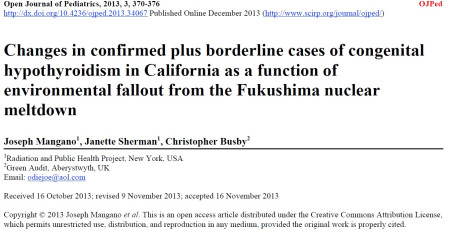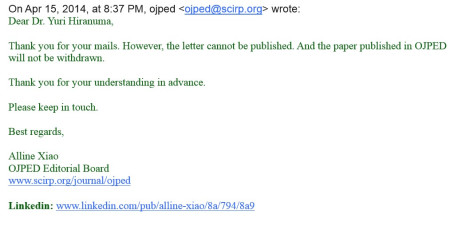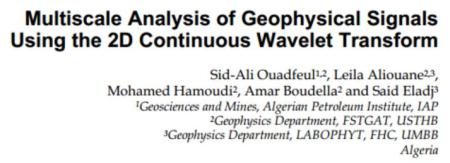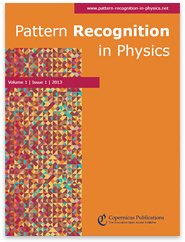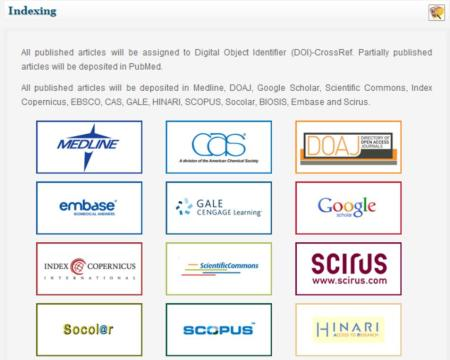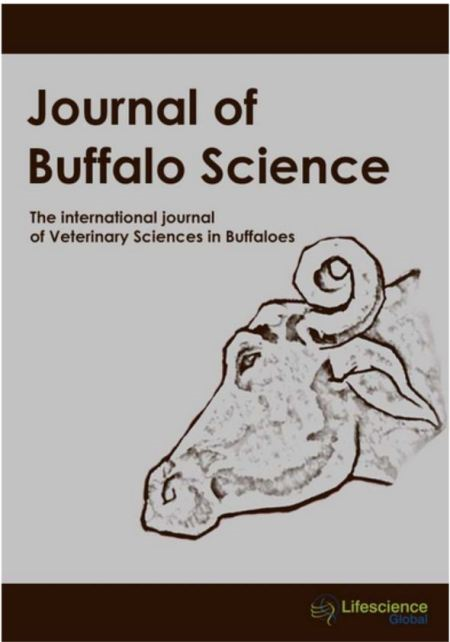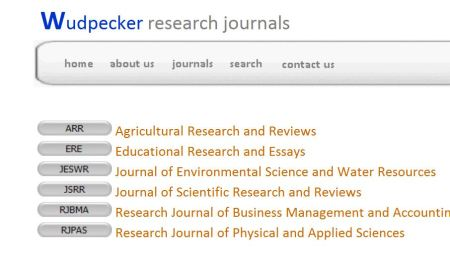Is Scientific Research Publishing (SCIRP) Publishing Pseudo-Science?

Scientific Research Publishing has published many articles by controversial researcher Mohamed El Naschie and his band of followers.
Scientific Research Publishing (SCIRP) says it has offices in China and Southern California, and like many questionable open-access publishers, it is registered in Delaware (and I wonder if the firm reports its income to the IRS).
This publisher has been on my list for a long time, and I recently described a case in which a controversial article about the Fukushima nuclear fallout was published in one of its many journals.
M. El Naschie is listed as the sole author on at least twenty articles in SCIRP journals. In my opinion, they are all nonsense and pseudo-science. El Naschie has reportedly been blacklisted from arXive, prohibited from posting preprints there.
Claimed Discovery of the Nature of Dark Energy
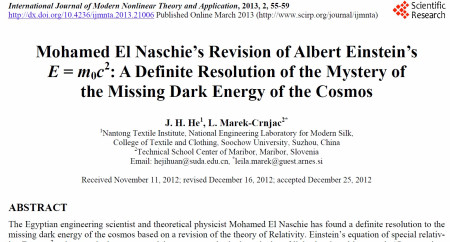
There are also many articles in SCIRP journals written by followers of El Naschie. These articles, like the one pictured here, typically report again on El Naschie’s findings. The one shown in the screenshot above reports on the “discovery” of the nature of dark energy. If such a discovery had truly been made, it would have been one of the major scientific discoveries of all time.
The nature of this published content is particularly surprising, given that H. Barry Zhou, the founder of Scientific Research Publishing, holds a Ph.D. in Space Plasma Physics from the University of Maryland at College Park. Why would someone with such credentials allow the publication of so many questionable articles claiming to have discovered the nature of dark energy and other such discoveries not accepted by the overwhelming majority of mainstream scientists?
Dr. Zhou, are you proud of publishing scholarly articles that fall way outside mainstream science? Scientific Research Publishing (SCIRP) has become a scholarly vanity press, in my opinion.
I am aware that El Naschie was the editor-in-chief of an Elsevier journal in the past. However, scientists protested, and his editorship was ended. I think additional, similar action is needed in this case.
In conclusion, if you want your work to appear in journals from a scientific press that has published many of the questionable scientific works of Mohamed El Naschie and his followers, then Scientific Research Publishing (SCIRP) is the publisher to select.
Appendix: I’ve included a list of some of Mohamed El Naschie’s articles published in SCIRP journals below.
http://www.scirp.org/journal/PaperInformation.aspx?PaperID=32969
o A Fractal Menger Sponge Space-Time Proposal to Reconcile Measurements and Theoretical Predictions of Cosmic Dark Energy
o A Resolution of Cosmic Dark Energy via a Quantum Entanglement Relativity Theory
o A Rindler-KAM Spacetime Geometry and Scaling the Planck Scale Solves Quantum Relativity and Explains Dark Energy
o A Unified Newtonian-Relativistic Quantum Resolution of the Supposedly Missing Dark Energy of the Cosmos and the Constancy of the Speed of Light
o Calculating the Exact Experimental Density of the Dark Energy in the Cosmos Assuming a Fractal Speed of Light
o Capillary Surface Energy Elucidation of the Cosmic Dark Energy—Ordinary Energy Duality
o Cosmic Dark Energy from ‘t Hooft’s Dimensional Regularization and Witten’s Topological Quantum Field Pure Gravity
o Dark Energy from Kaluza-Klein Spacetime and Noether’s Theorem via Lagrangian Multiplier Method
o Einstein’s General Relativity and Pure Gravity in a Cosserat and De Sitter-Witten Spacetime Setting as the Explanation of Dark Energy and Cosmic Accelerated Expansion
o Entanglement of E8E8 Exceptional Lie Symmetry Group Dark Energy, Einstein’s Maximal Total Energy and the Hartle-Hawking No Boundary Proposal as the Explanation for Dark Energy
o From Chern-Simon, Holography and Scale Relativity to Dark Energy
o From Yang-Mills Photon in Curved Spacetime to Dark Energy Density
o Nash Embedding of Witten’s M-Theory and the Hawking-Hartle Quantum Wave of Dark Energy
o Pinched Material Einstein Space-Time Produces Accelerated Cosmic Expansion
o Quantum Entanglement as a Consequence of a Cantorian Micro Spacetime Geometry
o Quantum Entanglement: Where Dark Energy and Negative Gravity plus Accelerated Expansion of the Universe Comes from
o The Hydrogen Atom Fractal Spectra, the Missing Dark Energy of the Cosmos and Their Hardy Quantum Entanglement
o The hyperbolic Extension of Sigalotti-Hendi-Sharifzadeh’s Golden Triangle of Special Theory of Relativity and the Nature of Dark Energy
o The Meta Energy of Dark Energy
o The Missing Dark Energy of the Cosmos from Light Cone Topological Velocity and Scaling of the Planck Scale
o Topological-Geometrical and Physical Interpretation of the Dark Energy of the Cosmos as a “Halo” Energy of the Schrödinger Quantum Wave
o What Is the Missing Dark Energy in a Nutshell and the Hawking-Hartle Quantum Wave Collapse
o Why E Is Not Equal to mc2
By: Jeffrey Beall
Follow on Twitter
Source: Scholarly Open Access
Comments:
AlexH says:
July 31, 2014 at 9:33 AM
Mohamed El Naschie also have some solid work, not just self- and pay-to-published articles. He published with Pergamon Press, in Springer, de Gruyter and other Elsevier journals beside C, S. & F so he is not a complete fraud, just someone who blew an academic bubble around himself which is constantly being poked from the outside.
Ole, Ole! says:
July 31, 2014 at 11:33 AM
What academic credentials are needed to judge papers on the cosmos, space plasma physics, Einstein’s E = mc2, and dark energy? What exactly is pseudo-science?
Jeanne A. Pawitan says:
July 31, 2014 at 11:24 AM
I am not an expert in physics, so I can not judge his articles. However, in my opinion, there is a possibility that Mohamed El Naschie has a thought beyond the thought of an ordinary scientist.
We have learnt about Galileo Galilei, who was labelled as heresy, because his peers can not understand and can not follow his thought, but now his theory is widely accepted.
So, who knows, the same will happen with Mohamed El Naschie, as his hypothesis may be proven to be true in the future, but before it happens, he will be bullied by everyone.
Quark says:
August 4, 2014 at 3:16 AM
Please not Galileo again ! It was inquisition which has “judged” him because of his work not lined up with religious beliefs, nothing to do with his “peer”. This is a plain sophistical comparison.
Dan Riley says:
August 7, 2014 at 1:53 PM
Galileo wasn’t persecuted because his peers didn’t understand him–he was persecuted because the Catholic Church found his conclusions uncomfortable, and he made some powerful political and theological (but not scientific!) enemies.
Galileos are very rare–for every actual Galileo, there are thousands and thousands of inappropriate Galileo comparisons. This is one of them.
For El Naschie to be shown to be correct, he would need to have a coherent theory capable of being tested. I am a physicist, and I have read several of his papers on relativity and dark matter. My professional judgement is that the papers I read fall in to the infamous “not even wrong” category–they are confused nonsense, not testable physical theories.

